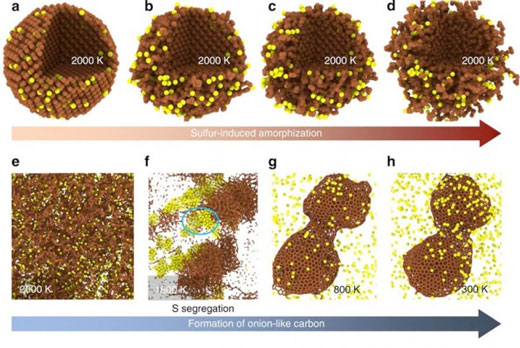| Aug 27, 2018 | |
Reducing friction with an onion-like carbon material(Nanowerk News) In 2015, a team from Argonne National Laboratory created a material with superlubricity (near-zero friction) at engineering scale. The material contained graphene and extremely small diamonds. The team replaced the graphene with molybdenum disulfide. The molybdenum disulfide causes a reaction that turns the diamonds into onion-like carbon. |
|
| The result? A self-generating, very low friction dry lubricant. As an added bonus, the material lasts much longer than other solid lubricants. | |
 |
|
| Atomistic simulations of the chemical mechanism leading to reduced friction. a–d: Atomic snapshots from simulations at selected times during the sulfur- (S-) induced amorphization of diamond nanoparticles. e–h: Atomic snapshots from simulations at selected times during the formation of onion-like carbon structures. (Image: Badri Narayanan and Subramanian Sankaranarayanan, Argonne National Laboratory) | |
| Superlubricity—a state in which friction essentially disappears—is a highly desirable property. Automobiles and other mechanical assemblies lose efficiency and wear down due to friction. Scientists developed a new material that achieves superlubricity in dry environments. Potential uses include wind turbine gears, magnetic disc drives in computers, and rotating seals. Argonne National Laboratory has three patents on the superlubricity technology. They have a patent pending on the latest breakthrough. It will soon be available for licensing. | |
| In 2015, a multidisciplinary team from Argonne National Laboratory created a material consisting of graphene, nanodiamond particles, and diamond-like carbon that demonstrated superlubricity at the macroscale for the first time. To inform the design of the material, the researchers coupled laboratory experiments at Argonne’s Tribology Laboratory and Center for Nanoscale Materials (CNM) with large-scale molecular dynamics simulations performed at the Argonne Leadership Computing Facility (ALCF) and the National Energy Research Scientific Computing Center (NERSC). | |
| The team has continued to further develop this lubricant technology. Most recently, they replaced the graphene with molybdenum disulfide to explore the impact of using other two-dimensional materials. | |
| In addition to performing detailed experimental investigations of the new material, the researchers carried out simulations on the ALCF’s Mira supercomputer to elucidate its behavior at the nanoscale. Using the LAMMPS (Large-scale Atomic/Molecular Massively Parallel Simulator) code, the team’s large-scale atomistic simulations revealed molecular insights into a mechanical stress-induced tribochemical reaction that led to superlubricity. | |
| They found that the molybdenum disulfide was breaking up into molybdenum and sulfur and reacting with the nanodiamonds to convert them into onion-like carbon structures, which consist of several layers of spherical graphitic shells that can be used as a dry lubricant. | |
| The material is a self-generating lubricant that re-adjusts itself continuously, causing it to last longer than traditional dry lubricants. The team published their findings in Nature Communications. | |
| To enable the computationally demanding molecular dynamics simulations, ALCF staff collaborated with IBM, Lawrence Berkeley National Laboratory, and Sandia National Laboratories to optimize the performance of LAMMPS for Mira and other many-core architectures. | |
References |
|
| D. Berman, B. Narayanan, M.J. Cherukara, S.K.R.S. Sankaranarayanan, A. Erdemir, A. Zinovev, and A.V. Sumant, “Operando tribochemical formation of onion-like-carbon leads to macroscale superlubricity.” Nature Communications 9, 1164 (2018). [DOI: 10.1038/s41467-018-03549-6] | |
| H.M. Aktulga, C. Knight, P. Coffman, K.A. O’Hearn, T.R. Shan, and W. Jiang, “Optimizing the performance of reactive molecular dynamics simulations for many-core architectures.” The International Journal of High Performance Computing Applications (2018). [DOI: 10.1177/1094342017746221] |
| Source: U.S. Department of Energy, Office of Science | |
|
Subscribe to a free copy of one of our daily Nanowerk Newsletter Email Digests with a compilation of all of the day's news. |
